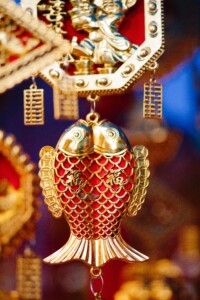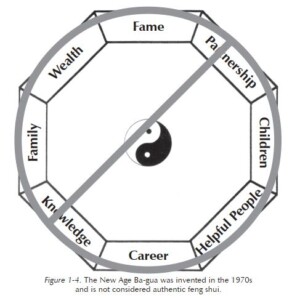 It’s October of 2022 and a new client just asked me a whole bunch of questions, making it obvious that his only exposure to Feng Shui has been through the pop culture New Age version called Black Hat, which became exceedingly popular in the 1990’s. This style of Feng Shui put the whole esoteric subject into the trendy “wheelhouse” of celebrities, name brand corporations, and virtually every design show on cable TV. A Feng Shui master, Pun Yin, even made it to the White House to advise Bill Clinton.
It’s October of 2022 and a new client just asked me a whole bunch of questions, making it obvious that his only exposure to Feng Shui has been through the pop culture New Age version called Black Hat, which became exceedingly popular in the 1990’s. This style of Feng Shui put the whole esoteric subject into the trendy “wheelhouse” of celebrities, name brand corporations, and virtually every design show on cable TV. A Feng Shui master, Pun Yin, even made it to the White House to advise Bill Clinton.
Actually, the phrase “Black Hat” is a reference to Black Hat Tantric Buddhism. The creator of the Black Hat School (the late Thomas Lin Yun) thought it would be cool to market his brand of Feng Shui, as if it were associated with this branch of Buddhism. Meanwhile, the Black Hat Tantric monks released a statement decades ago, saying that they had nothing to do with this emerging lifestyle brand of Feng Shui.
Next, the term “black hat” became associated with certain shunned computer hacker practices, so the Black Hat Feng Shui School re-branded themselves as simply “BTB” Feng Shui. Again, the “BTB” stands for Black Hat Tantric. (Apparently, these monks wore a literal black hat as part of their religious garb.) This may be on par with someone creating a school called “Catholic Feng Shui,” when Catholicism publicly rejects occult practices. The first chapter of my first book goes into greater detail about the Black Hat School.
Thomas Lin Yun was teaching English as a second language in Hong Kong when westerner Sarah Rossbach became his groupie and the rest is history. While there was no evidence that Lin Yun held any higher academic degrees, he was initially introduced to the West as “Professor” Lin Yun. When his Feng Shui cult began in San Francisco circa the late 1980’s, his disciples began to call him “Master” Lin Yun. Eventually they called him “Grand Master.” I learned later that the title of “Grand” Master was historically only bestowed upon a master who had passed on or one who legitimately advanced the natural science of Feng Shui with new discoveries or applications. Without berating the man any further, let’s just say that his brand of Feng Shui was very simple and generic, appealing to a whole new generation of unquestioning Baby Boomers.
He created a “Ba’ gua Map” purporting Eight Life Stations, which could be super-imposed over any floor plan. Those Life Stations included the infamous “Love Corner” and “Wealth Corner” which he claimed are located in the same locations in every house. With this make-believe map, one could place placebos and other trinkets in order to stimulate good fortune, in addition to a whole trunk load of Chinese folk remedies, creating almost a “cargo cult,” to quote an early Black Hat critic, Cate Bramble.

I began my own Feng Shui practice in earnest in the early 1990’s and to this day I have mixed feelings about this “BTB” School. On the one hand, I got a ton of business coming in as a second opinion after so many people failed to realize any benefits from using the BTB New Age pseudo-version of Feng Shui. It gave me an opportunity to re-educate people about what is real Feng Shui and what is Fake Feng Shui. On the other hand, I wish the BTB school never came into being because it seriously tarnished the integrity and validity of genuine Feng Shui. One of the more disturbing results was to see certain Chinese personalities (who should have known better) embrace the New Age garbage, just so they could join the money-making bandwagon.
Lin Yun’s followers were prolific and wrote the vast majority of Feng Shui books back in the 1990’s and early 2000’s when stores like Barnes & Noble created entire Feng Shui sections on their shelves. Feng Shui was so popular during that time, that bookstores allowed me to give presentations, even before I had written my own books. At that time, I told the bookstores I could help them sell Feng Shui books, but my list of approved authentic books was quite small, including one title by Master Lam Kam Chuen and the self-published Principles of Feng Shui by Master Larry Sang.
Since the BTB School relates a One-Size-Fits-All approach, where the back left-hand corner of every floor plan is a supposed “wealth corner,” it is very easy to appeal to the common sense of most people and point out the obvious that all structures cannot possibly be so similar. But it was the simplicity of the BTB methodology which gave birth to western “feng shui masters” who had done little more than read a few books by Lin Yin’s followers or take a weekend seminar before they felt qualified to consult professionally. Compare this to a conversation I had with actual Feng Shui Master Eva Wong, when she told me that private students usually study with her for “about eight years.”
To be clear, there are many different schools of classical Feng Shui, having evolved for centuries or longer. Some of these schools are quite different and may contradict each other, so I don’t want to imply that Lin Yun’s Feng Shui cult was the first of its kind. In the current times, many classically trained practitioners are doing a hybrid version of several different schools, in part because we want to offer as much as possible to our clients. If a technique from one school doesn’t apply, then let’s try another technique from another school. It’s more about having a well-rounded education and benefiting from the discoveries made by different highly regarded masters from history.
****Author’s Note: After this article was published, I was accused of being disrespectful of the BTB School and Lin Yun. It’s imperative for readers to know that I am not alone in my criticism. If anyone is interested in a compilation of articles I have saved from the 1990’s (WRITTEN BY OTHERS, NOT BY ME), about how Feng Shui was perceived (and investigated) during the heyday of the Black Hat phenomenon, contact me and I will be happy to send you the file. Below is just Page One, from the Chinese Daily News, July 8, 1997:

Author: Kartar Diamond
Company: Feng Shui Solutions ®
From the Feng Shui History and Culture Series
